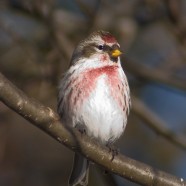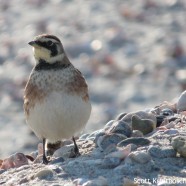Common Redpoll Irruption Update
This is a companion blog entry to the Winter Bird Forecast by Audubon Connecticut and the Roger Tory Peterson Institute of Natural History. The first two forecasts were published recently: “Cloudy with a Chance of Snowys” and “Expect the Unexpected”. The third will be coming soon! The Common Redpoll (Acanthis flammea) was predicted to make a “moderate to good flight” this fall and winter due to “variably poor to average” birch seed crops in the boreal forest according to Ron Pittaway’s 2014-15 winter finch forecast. Nearly a month ago I started to notice more reports...
Read MoreSavannah Sparrow (Passerculus sandwichensis)
Here we have an attentive Savannah Sparrow (Passerculus sandwichensis), a winter landbird species that you should be on the lookout for mixed in with other sparrows. They can be found especially near any farmlands, fields, grasslands and coastal areas, looking for seeds to devour. If there is a snowfall you can find them seeking out areas near water or plowed habitat that provides unexpectedly helpful access to grasses. This is a more typical Savannah Sparrow, but if you live on the Atlantic Coast be mindful of finding the large, pale “Ipswich” Savannah Sparrow on beaches and...
Read MoreSnowy Owls spreading south
In the past week, since I posted this entry about another possible irruption, more Snowy Owls have moved in to southern Canada and the United States. One bird was found and photographed by Michele Rundquist-Franz, President of the Presque Isle Audubon Society, in Erie, Pennsylvania, not too far from us at the Roger Tory Peterson Institute of Natural History in Jamestown, New York. Local excitement went up another level this weekend as two Snowy Owls appeared here in our own Chautauqua County on Saturday, November 15, both at the Dunkirk Airport. The first was found in the morning by our...
Read MoreAmerican Pipit (Anthus rubescens) in HD
Right now the migrating American Pipit (Anthus rubescens) can be found on farms and fields in areas such as Chautauqua County to the shores of Lake Erie or the Atlantic Coast. You may see one individual or you may see dozens. This HD video shows how much they as a species enjoy bobbing their tails. It may be a “drab” bird due to its preference for open areas but it certainly has an understated zest.
Read MoreHorned Lark (Eremophila alpestris)
The Horned Lark (Eremophila alpestris) is a species of open areas – the tundra, grasslands, fields, beaches and dunes and even the desert. Unsurprisingly they feed on the ground on insects and seeds and often take advantage of human activity disturbing areas such as mowed airports or piles of plowed earth or snow that expose more food. When it comes to the winter you will find them wherever it is the most bare. You can frequently spot them with Snow Buntings and, more rarely, the Lapland Longspur. They are also another species decreasing across much of their range and are listed as...
Read More








